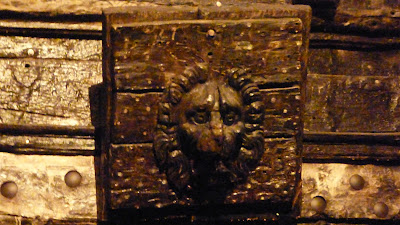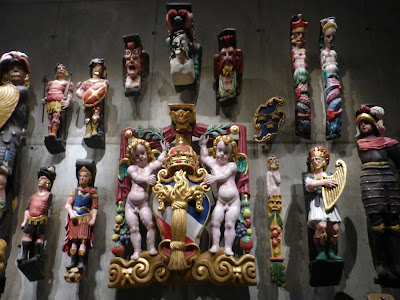This is the Vasa Museum, home to a 17th century warship. The Vasa set sail on her maiden voyage on 10th Aug 1628 and sank in Stockholm harbour. The ship sank as soon as they raised the sails as the ship was top heavy without enough ballast. Once the ship keeled, over water poured in through the gun ports and she sank having sailed just 1300m. it is estimated that around 30 out of the 150 people on board died.

The wreck was salvaged in 1961 after 333 years under the sea. It took over a year and a half to raise the ship from the sea bed. They managed to keep the hull intact and refloat it to transport it to where they would begin the long process of preserving the ship.
 The figurehead is a lion holding the heraldic arms of the Vasa dynasty, a corn sheaf (vasa) after which the ship was named. King Gustav II Adolf who commissioned the ship was known as the Lion of the North. The impressive figurehead is 3m long.
The figurehead is a lion holding the heraldic arms of the Vasa dynasty, a corn sheaf (vasa) after which the ship was named. King Gustav II Adolf who commissioned the ship was known as the Lion of the North. The impressive figurehead is 3m long.

You get some idea of the size of the ship looking down at the visitors below.
The ship has been beautifully restored with an incredible 98% of it original.
The three crowns have been part of the Swedish coat-of-arms since the 14th cent.
On the roofs of the Quarter Galleries are sea creatures (tritons and mermaids). Underneath are Roman Warriors.
Many of the ships 500 sculptures were found on the stern. Although it was damaged it has been painstakingly restored. The lighter coloured wood is not original.

If you are ever in Stockholm this is one museum not to be missed.

The wreck was salvaged in 1961 after 333 years under the sea. It took over a year and a half to raise the ship from the sea bed. They managed to keep the hull intact and refloat it to transport it to where they would begin the long process of preserving the ship.
 |
 The figurehead is a lion holding the heraldic arms of the Vasa dynasty, a corn sheaf (vasa) after which the ship was named. King Gustav II Adolf who commissioned the ship was known as the Lion of the North. The impressive figurehead is 3m long.
The figurehead is a lion holding the heraldic arms of the Vasa dynasty, a corn sheaf (vasa) after which the ship was named. King Gustav II Adolf who commissioned the ship was known as the Lion of the North. The impressive figurehead is 3m long.
You get some idea of the size of the ship looking down at the visitors below.
The ship has been beautifully restored with an incredible 98% of it original.
15 of the ship's sculptures have been reproduced in their original colours. It took 12 years of paint research to recover and analyse the colours.
The three crowns have been part of the Swedish coat-of-arms since the 14th cent.
On the roofs of the Quarter Galleries are sea creatures (tritons and mermaids). Underneath are Roman Warriors.
Many of the ships 500 sculptures were found on the stern. Although it was damaged it has been painstakingly restored. The lighter coloured wood is not original.


















Very cool. History rocks.
ReplyDeleteOh what a very interesting exhibit.
ReplyDeleteWorth a Thousand Words
Fascinating historical photos ~ thanks, ^_^
ReplyDelete(A ShutterBug Explores)
Very interesting. Maybe if they paid more attention to basic design instead of art works and carving, such an expensive ship would not have been lost. It is a very impressive restoration.
ReplyDeleteWow - amazing they were able to raise and restore this ship. Interesting history.
ReplyDeleteThat is incredible I would really love to see that. It's a better version of our Mary Rose which sunk in similar circumstances. Awesome detail on the ship
ReplyDeleteAmazing is was preserved so well in the sea.
ReplyDeleteWow! This is incredible and so well preserved. Thanks for the information and wonderful pictures. :-)
ReplyDeleteWonderful carvings and restoration! Boats are, indeed, on my mind right now as I watch what is going on in Texas.
ReplyDeleteGreat shots of museum. I like this wood work.
ReplyDeleteAgreed - it might sound boring, but it really is a wonderful museum!
ReplyDeleteThat has been an incredible restoration project! How amazing after 333 years under the sea!
ReplyDeleteWren x
What an amazingly well preserved and restored ship - it looks fascinating.
ReplyDeleteA sad short life for such a beautiful ship. The carvings are amazing.
ReplyDeleteSo incredibly ornate for a ship! Amazing that it has been so well preserved during the hundreds of years it was submerged - I guess the quality of the wood and cold waters would have been beneficial to its longevity.
ReplyDeleteVery nice pictures of the museum and the ship. The three crowns are until today a symbol of Sweden. For instance their ice hockey team is also called the three crowns.
ReplyDeleteI was there in the 1980s and it looks just the same! I really liked the museum and enjoyed seeing your detail close-ups once again.
ReplyDelete